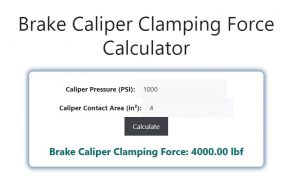About Brake Caliper Clamping Force Calculator (Formula)
Understanding the clamping force of brake calipers is crucial for ensuring effective braking performance in vehicles. The clamping force directly affects the braking power and stability, which are essential for safety during driving. A Brake Caliper Clamping Force Calculator allows automotive engineers and enthusiasts to accurately calculate this force using simple measurements. In this article, we will explain the formula used in the calculation, provide step-by-step instructions on how to use the calculator, and answer common questions regarding brake caliper clamping force.
Formula
The formula for calculating the brake caliper clamping force is:
BCF = Caliper Pressure * Caliper Contact Area
Where:
- BCF represents the Brake Caliper Clamping Force.
- Caliper Pressure is the hydraulic pressure applied to the caliper, typically measured in psi or bar.
- Caliper Contact Area refers to the surface area of the brake pad in contact with the brake disc, measured in square inches or square centimeters.
How to Use
- Measure Caliper Pressure: Use a pressure gauge to measure the hydraulic pressure applied to the brake caliper. Ensure that the measurement is in psi or bar for consistent results.
- Determine Caliper Contact Area: Calculate the contact area of the brake pad that engages with the brake disc. This can be done by measuring the width and height of the brake pad and using the formula for the area of a rectangle (Area = Width x Height).
- Insert Values into the Formula: Plug the measured values into the formula BCF = Caliper Pressure * Caliper Contact Area.
- Calculate the Clamping Force: Perform the calculation to obtain the brake caliper clamping force.
Example
Let’s assume we have the following measurements:
- Caliper Pressure: 1000 psi
- Caliper Contact Area: 4 square inches
Using the formula, we can calculate the Brake Caliper Clamping Force:
- BCF = 1000 psi * 4 in²
- BCF = 4000 pounds of force
In this example, the clamping force exerted by the brake caliper is 4000 pounds.

FAQs
- What is brake caliper clamping force?
Brake caliper clamping force is the force exerted by the brake caliper to press the brake pads against the brake disc, allowing the vehicle to slow down or stop. - Why is clamping force important?
Adequate clamping force is essential for effective braking performance, stability, and safety during vehicle operation. - How is caliper pressure measured?
Caliper pressure is measured using a hydraulic pressure gauge connected to the brake system. - What units are used for clamping force?
Clamping force is typically measured in pounds (lb) or Newtons (N). - How do I calculate caliper contact area?
The contact area can be calculated by measuring the width and height of the brake pad and multiplying these dimensions (Area = Width x Height). - What factors affect clamping force?
Factors include caliper pressure, contact area, brake pad material, and hydraulic fluid properties. - How does brake pad material impact clamping force?
Different materials have varying coefficients of friction, which can influence the effective clamping force during braking. - Is there a standard clamping force for all vehicles?
No, the required clamping force varies by vehicle type, weight, and braking system design. - Can clamping force be adjusted?
Yes, clamping force can be adjusted by modifying the caliper pressure or using brake pads with different contact areas. - What happens if the clamping force is too low?
Insufficient clamping force can lead to poor braking performance, longer stopping distances, and increased risk of accidents. - What happens if the clamping force is too high?
Excessive clamping force can cause brake pad wear, overheating, and potential damage to the braking system. - How often should I check clamping force?
It’s advisable to check clamping force during routine brake inspections or whenever brake components are replaced. - What tools do I need to measure caliper pressure?
A hydraulic pressure gauge and appropriate fittings are needed to accurately measure caliper pressure. - Can I use the calculator for different types of vehicles?
Yes, the calculator can be used for various vehicles, but ensure you use the correct measurements for each specific application. - How do I know if my brake caliper is functioning properly?
Signs of a malfunctioning brake caliper include uneven brake pad wear, decreased braking performance, or visible leaks. - What maintenance is required for brake calipers?
Regular inspections, cleaning, and replacing worn brake pads are essential for maintaining brake calipers. - Are aftermarket brake components reliable?
Many aftermarket components can be reliable, but it’s crucial to choose reputable brands and verify compatibility with your vehicle. - What is the impact of brake fluid on clamping force?
The quality and type of brake fluid can affect hydraulic pressure and, consequently, the clamping force exerted by the caliper. - Can caliper design affect clamping force?
Yes, the design of the caliper, such as single vs. dual-piston, can influence the distribution of force and overall braking performance. - Where can I find more information on brake caliper systems?
Manufacturer manuals, automotive repair guides, and professional training resources can provide additional information on brake caliper systems.
Conclusion
The Brake Caliper Clamping Force Calculator is a valuable tool for anyone involved in automotive maintenance and engineering. By understanding the relationship between caliper pressure and contact area, users can ensure optimal braking performance and safety. Regularly calculating and monitoring clamping force helps maintain the integrity of the braking system, ultimately contributing to safer driving experiences.
